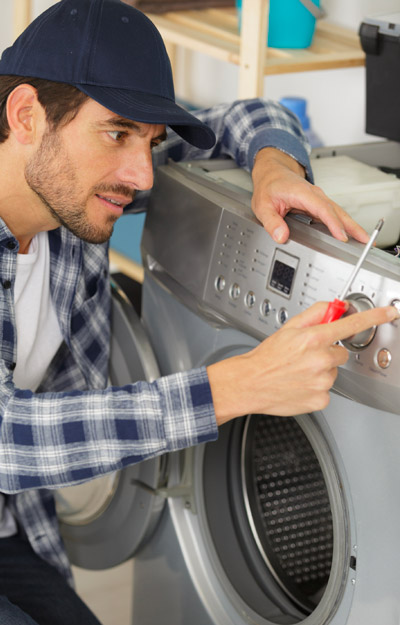Enter the code USA15 at checkout to apply your discount. Discount will be applied at checkout when the code is entered & applies to all parts. Cannot be combined with any other coupon or special offer & cannot be applied to a previously placed order. Not valid toward tax or shipping & handling. Discount has no cash value. Discount expires on July 1 at 11:59pm EST.
Appliance Parts
- Accessories
- Dishwasher
- Dryer
- Stove / Oven
- Microwave
- Refrigerator
- Washer
- See more... See less...
Lawn Equipment Parts
- Lawn Mower
- Chainsaw
- Blower
- Generator
- Air Compressor
- Lawn Tractor
- Pressure Washer
- See more... See less...
5 Appliance Myths Busted
By Steve Ash
We've all come across a myth or urban legend. Fortunately, most of us know how to spot a tall tale when it crosses our path, usually because it just sounds down right crazy. But what do you do when the myth actually sounds plausible? With all the myths swirling around the food we eat, medical procedures and, at the extreme edge of the myth universe, otherworldly creatures, it's not surprising that there are also many myths about the appliances in our homes. Fortunately, as you're about to learn, most appliance myths are just tall tales.
MYTH 1 Microwaves emit radiation that can harm you: FALSE
This is easily the most popular of all the appliance myths. Most of us can probably remember being scolded by our mothers for standing too close to the microwave while it is running. Reason being if you stood too close, the radiation from the microwave would get you too!
Microwaves do use radiation to cook. But here's the good news - it's only harmful if you experience direct contact, meaning you'd actually have to get inside the microwave, close the door and set yourself to cook.
Since most of us have enough sense not climb inside the microwave, there's no need to fear the mighty microwave. The only way microwave radiation can escape is if there is a leak in the door seal. Knowing this, you need to keep your microwave properly maintained and never try to repair it yourself.
MYTH 2 Dishwashers completely fill with water when operating: FALSE
Repair technicians should be familiar with this myth as many homeowners express concern about opening their dishwasher during the wash cycle for fear that gallons of water will pour out like a waterfall onto their kitchen floor.
While this myth does actually sound quite plausible, again, it's totally false. Only the bottom of the dishwasher tub (below the level of the door) fills with water. A pump-driven impeller, located in the bottom of the dishwasher tub, pushes water through tiny jet-holes located in spray arms that rotate during the wash and rinse cycles, spraying water on everything inside the dishwasher.
So, the next time you need to open your dishwasher mid-cycle, don't hesitate! The most you'll get is a bit of steam in your face.
MYTH 3 Dishes need to be "pre-rinsed" before being washed in a dishwasher: FALSE
Debunking this myth should make household chore-doers very happy. As ridiculous as it sounds to rinse a dish before putting it in the dishwasher, just to be rinsed again, there are thousands of kitchen dwellers devoted to removing every trace of food from their dinnerware before placing it in the dishwasher.
News flash... you can eliminate the dreaded "pre-rinse" because it does not help your dishwasher get your dishes and cutlery any cleaner. Pre-rinsing can actually harm your dishes because the concentration of alkaline in the dishwasher detergent becomes way higher than normal. After all, detergent is made to clean stuck-on grease and grime, so without bits of food to attack, the alkaline level, now higher than normal, attacks your dishes, making them appear cloudy, scratched and in some cases, etched. Let's be realistic though, don't leave a half-eaten sandwich on your plate and put in the dishwasher.
MYTH 4 Appliances don't use power while in stand-by mode: FALSE
You're not alone if you think that appliances in "stand-by" mode don't use power. You'd be surprised how much energy a "sleeping" appliance can consume. Almost all home appliances and electronics continue to consume power when in "stand-by".
Check out these stand-by power consumption rates:
- Microwave oven: up to 6 watts per hour
- Ranges: up to 4.1 watts per hour
- Telephone: up to 5 watts per hour
In some cases, appliances in stand-by mode can consume as much as 15-30 watts per hour - that's a lot of power usage day after day, week after week.
You can reduce or eliminate excess power consumption, do your part to save the environment, and save yourself some money by simply powering down your appliances completely or unplugging them when they're not in use.
MYTH 5 Washing dishes by hand uses less water than a dishwasher: FALSE
Here's a real classic to close off our top five myths list. Many homeowners believe they're helping the environment and reducing their water bill by washing dishes the old-fashioned way rather than using a dishwasher. Nothing could be further from the truth.
Modern dishwashers use, on average, 1-1.5 kilowatt hours of energy and 3.7 gallons of water (an amount equal to one full kitchen sink). Take into consideration how many full sinks you use to wash a pile of dishes and the amount of water you use for rinsing the dishes and it's easy to see how wrong this myth is. Washing by hand consumes much more water than using your dishwasher, especially when you consider that washing dishes by hand is a daily affair whereas you may only run your dishwasher every 2 or 3 days.
5 Appliance Myths Busted
Use your appliances properly and you have nothing to fear. Still have a concern about one or more of your appliances? Do your research and read your appliance manuals. Above all, don't believe everything you hear or read - except this article of course.
- Search your model number to find:
- Genuine OEM parts guaranteed to fit
- Free manuals and guides
- Repair instructions and videos



































